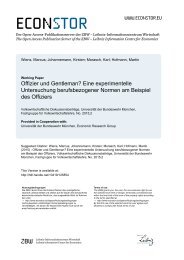DISCUSSION
n?u=RePEc:iza:izadps:dp10283&r=exp
n?u=RePEc:iza:izadps:dp10283&r=exp
Create successful ePaper yourself
Turn your PDF publications into a flip-book with our unique Google optimized e-Paper software.
2 Design of our field experiments<br />
2.1 Description of the sample<br />
We ran our field experiments at a public university in the United States. Our subjects were<br />
undergraduate students enrolled in a large semester-long introductory course. As described in<br />
Section 2.2, we sought consent from all our subjects (the consent rate was ninety-eight percent).<br />
Approximately four thousand students participated in total. We employed a between-subjects<br />
design: each student was randomized into the Treatment group or the Control group immediately<br />
on giving consent. Students in the Treatment group were asked to set goals while students in the<br />
Control group were not asked to set any goals. As described in Section 2.3, in the Fall 2013 and<br />
Spring 2014 semesters we studied the effects of performance-based goals on student performance<br />
in the course (the ‘performance-based goals’ experiment). As described in Section 2.4, in the Fall<br />
2014 and Spring 2015 semesters we studied the effects of task-based goals on task completion<br />
and course performance (the ‘task-based goals’ experiment). 8<br />
Table 1 provides statistics about participant numbers and treatment rates. We have information<br />
about participant demographics from the university’s Registrar data: Tables SWA.1,<br />
SWA.2 and SWA.3 in Supplementary Web Appendix I summarize the characteristics of our<br />
participants and provide evidence that our sample is balanced. 9<br />
All semesters<br />
Fall 2013 & Spring 2014 Fall 2014 & Spring 2015<br />
(Performance-based goals) (Task-based goals)<br />
Number of participating students 3,971 1,967 2,004<br />
Number of students in Treatment group 1,979 995 984<br />
Number of students in Control group 1,992 972 1,020<br />
Fraction of students in Treatment group 0.50 0.51 0.49<br />
Notes: The number of participating students excludes: students who did not give consent to participate; students<br />
who formally withdrew from the course; students who were under eighteen at the beginning of the semester;<br />
students for whom the university’s Registrar data does not include SAT or equivalent aptitude test scores; and<br />
one student for whom the Registrar data does not include information on gender.<br />
Table 1: Participant numbers and treatment rates.<br />
2.2 Course structure<br />
In all semesters, a student’s letter grade for the course was based on the student’s total points<br />
score out of one hundred. 10 Points were available for performance in two midterm exams, a final<br />
exam and a number of online quizzes. Points were also available for taking an online syllabus<br />
quiz and a number of online surveys. For the Fall 2013 semester Figure 1 gives a timeline of<br />
8 We also ran a small-scale pilot in the summer of 2013 to test our software.<br />
9 For each characteristic we test the null that the difference between the mean of the characteristic in the<br />
Treatment Group and the Control group is zero, and we then test the joint null that all of the differences equal<br />
zero. The joint test gives p-values of 0.636, 0.153 and 0.471 for, respectively, all semesters, Fall 2013 and Spring<br />
2014 (the performance-based goals experiment), and Fall 2014 and Spring 2015 (the task-based goals experiment).<br />
See Tables SWA.1, SWA.2 and SWA.3 for further details.<br />
10 The grade key is at the bottom of Figure SWA.1 in Supplementary Web Appendix II.<br />
5




